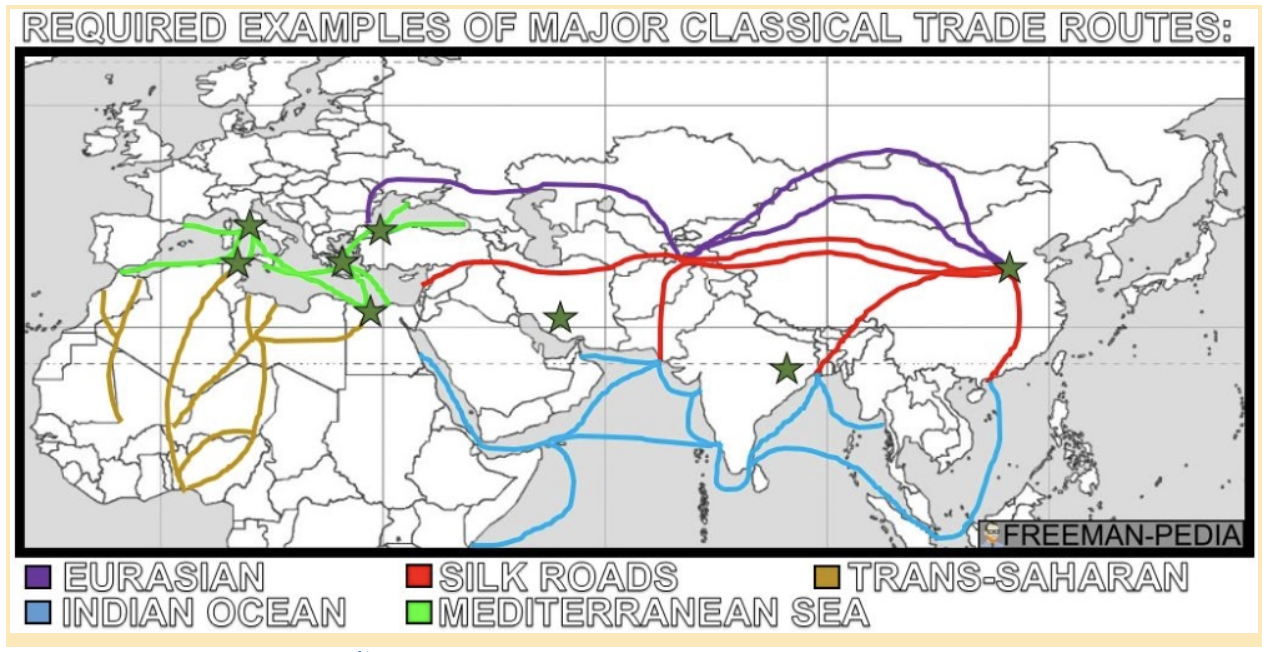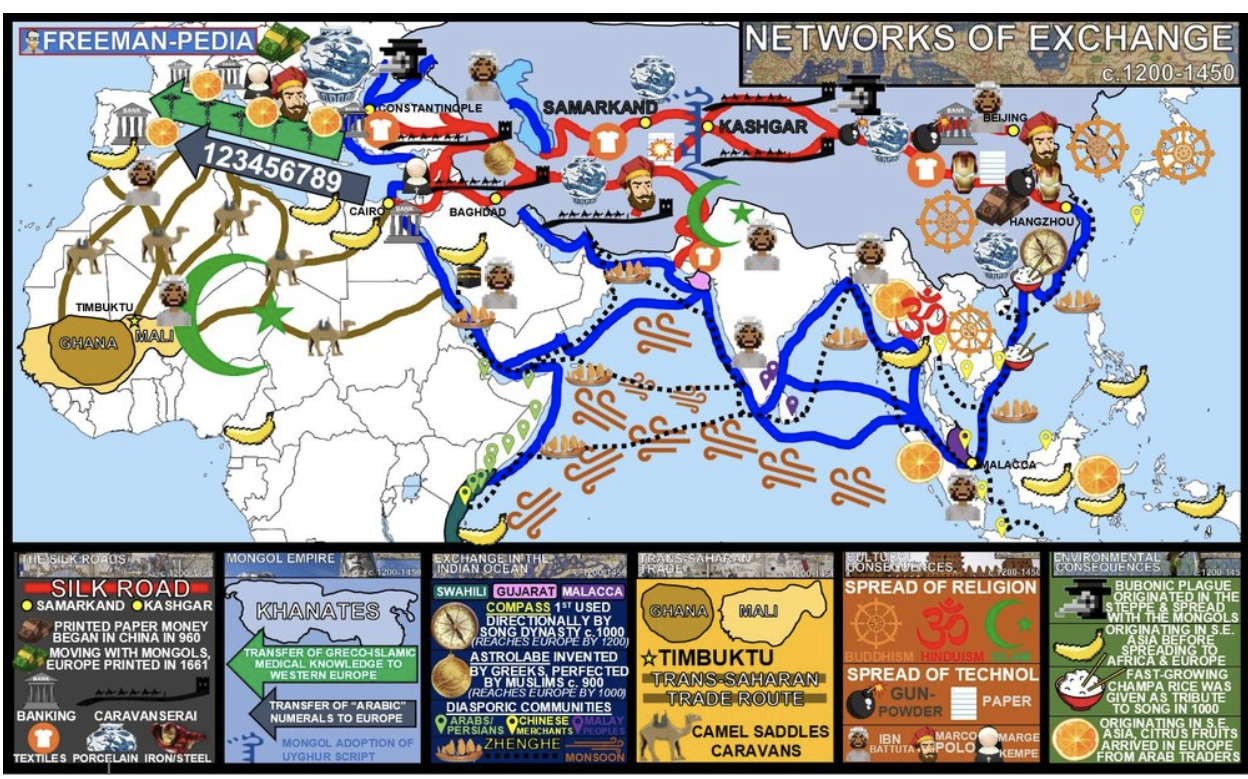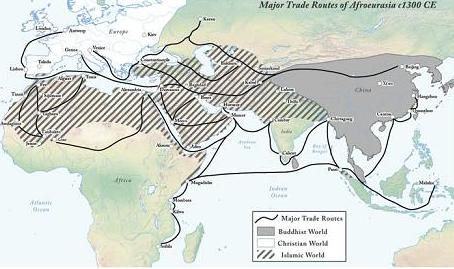K
Katie Moore
Riya Patel
AP World History: Modern 🌍
577 resourcesSee Units
Welcome to the second unit of AP World History! This unit covers the same time period as Unit 1 (1200-1450). However, where unit 1 discussed the political structures in the world during this time, this unit, called “Networks of Exchange,” discusses the major worldwide economic changes.
The increase in global trade networks is what will mark the post-classical era. This unit covers the ways that these trade networks facilitated economic and cultural exchanges and how trade changed between the classical and post-classical eras. The curriculum focuses on the Silk Roads, Indian Ocean Trade Routes, and Trans-Saharan Trade Routes, along with their effects on culture, the environment, technology, and the global economy.
Trade Routes
Silk Roads
The Silk Road was a network of trade routes that connected the East and West and was an important means of cultural exchange between the ancient civilizations of China, India, Europe, and the Islamic world. The Silk Road derived its name from the lucrative trade in Chinese silk that began during the Han Dynasty (202 BC – 220 AD). The Silk Road was not a single road, but rather a network of routes that spanned thousands of miles across land and sea. These routes were used to transport a wide variety of goods, including silk, spices, gold, and other luxury items. The Silk Road was also an important means of cultural exchange, and it played a significant role in the spread of ideas, religion, and technology between the civilizations of the East and West. The Silk Road declined in the 14th century with the rise of sea trade routes, but it remains an important symbol of cultural exchange and trade in world history.
Indian Ocean Trade Routes
The Indian Ocean trade routes were a network of sea routes that connected the East and West and facilitated trade and cultural exchange between the ancient civilizations of Africa, the Middle East, India, Southeast Asia, and East Asia. These trade routes were used to transport a wide variety of goods, including spices, textiles, gold, and other luxury items. The Indian Ocean trade routes were an important means of cultural exchange, and they played a significant role in the spread of ideas, religion, and technology between the civilizations of the East and West. The Indian Ocean trade routes were also a key factor in the development of the economies and cultures of the countries and regions along their routes. The Indian Ocean trade routes declined in the 15th century with the rise of the Atlantic trade routes, but they remain an important part of world history.
Trans-Saharan Trade Routes
The Trans-Saharan trade routes were a network of land-based trade routes that connected West Africa with the Mediterranean and the Middle East. These trade routes were used to transport a wide variety of goods, including gold, salt, ivory, and other luxury items. The Trans-Saharan trade routes were an important means of cultural exchange, and they played a significant role in the spread of ideas, religion, and technology between the civilizations of Africa and the Middle East. The Trans-Saharan trade routes were also a key factor in the development of the economies and cultures of the countries and regions along their routes. The Trans-Saharan trade routes declined in the 16th century with the rise of the Atlantic trade routes, but they remain an important part of world history.
Contextualizing The Unit
Before we look at the new changes in global trade in the period 1200-1450, let’s take a quick look at the big picture. Major trade routes grew during the classical period between 600 BCE and 600 CE. These included the Silk Roads and Indian Ocean Routes. These trade routes connected empires such as the Roman Empire, Han China, and the Mauryan and Gupta Empires in India, which allowed goods and ideas to transfer between empires. After the fall of Rome and Han China, the post-classical era began and ushered in a new era of expanded trade. As empires like the Byzantine Empire, Abbasid Caliphate, and the Majapahit grew, so did trade. This unit can be contextualized by understanding the basic idea that during the post-classical era, new human connections began, and the existing connections expanded. Take a look at these two maps from the classical era and post-classical era showing this change:


Effects of Growth in Trade
Economic Impacts
As an economic activity, the expansion of trade fundamentally changed the way the global economy functioned. More than ever, empires relied on trade to grow and consolidate power along with spreading influence. In China, people began to use new financial tools, such as paper money, as a medium of exchange for goods. Many empires grew explicitly because of the increase in trade, such as the trade empires along the Swahili Coast in Africa or Southeast Asian empires. New technology such as the saddle and new boats such as Islamic dhows and Chinese junks also sped up the rate at which trade continues. Groups of traders known as caravans increased the supply of trade goods and trade cities such as Timbuktu and Samarkand grew as trade centers. These economic impacts will continue into future units as the growth of trade becomes a global trend that doesn’t stop. This time period marks the beginning of expanded connections between humans which through the years does not end. We’ll see the growth of global trade and then globalization in the 20th century, which all starts with the economic growth during the post-classical period.
Cultural Impacts
Trade is not just about goods but also about ideas. As travelers moved from empire to empire, they spread cultural ideas such as religion. During this time period, trade was the primary way religions such as Islam, Hinduism, and Buddhism spread. The main way this occurred was through proselytization: attempts at active conversion. Some religions, such as Judaism, do not proselytize, but many like Islam and Christianity do. Trade also facilitated the spread of technology from empires, such as the Abbasid Caliphate and Song China, renowned for their scientific and mathematical knowledge, to other areas of the world, notably Europe. The Abbasids invented trade technologies such as the astrolabe that allowed for navigation. The Chinese invented the compass and, most importantly, gunpowder, which will greatly impact militaries in the following periods. You’ll also learn about interregional travelers such as Ibn Battuta and Marco Polo and the significance of their journeys.
Environmental Impacts
The environmental impacts of growing trade break down into two major categories: food and disease. Food was essential, and therefore one of the primary trade goods during this time. Specifically, bananas and citrus fruits are notable examples of foods that traveled west. Another food, Champa rice, is crucial to agricultural and population growth in China. Similarly, disease traveled along trade routes across the world. The best example of this is the Bubonic Plague, also known as the Black Death, which killed upwards of a third of the population of Europe, but originated in rats in the Yuan Dynasty. History recognizes the Bubonic Plague not only as an important event to the world's population at that time but leading to what would become the rise of Europe near the end of this time period. Humans also used animals like camels to aid in trade along routes, especially in Africa.
Conclusion
Unit 2 is incredibly useful in AP World, explaining many political, economic, and social changes that accompany the time period between 1200 and 1450. Trade is essential to everything in AP World, which is especially true for period 1. There's a common phrase in AP World: "when in doubt, trade." Remember this because trade is usually an answer to pretty much any question! In period 1, the cause and/or context for most developments often links to the growth in trade that we see in unit 2. Good luck!
Main Events
1095-1492: Crusades
1258 CE: Mongols sack Baghdad (end of the Abbasid Caliphate)
1271 – 1295 CE: Marco Polo’s Travels
1279: Peak of Mongol and Pax Mongolica on the Silk Roads
1299-1921: Ottoman Empire
1324 CE: Mansa Musa’s pilgrimage
1325 – 1349 CE: Ibn Battuta’s Travels
1347 – 1348 CE: Bubonic Plague in Europe
1405 – 1433 CE: Zheng He’s voyages
Major Trends Between 1200-1450
- More Trade → Trade of Commercial Tech
- Examples of commercial technologies include: Astrolabe, compass and caravanserai
- New Commercial Tech → Commercial Growth
- State practices and highly developed commercial infrastructure led to commercial growth
- State Practices: Grand Canals, Hanseatic League & Inca Road System
- Commercial Infrastructure: Grand Canal
- Expansion of empires through trade
- Empires that expanded: Mongols, Islamic Empire, Byzantium Empire and Imperial China
- Migration of people → Cross Exchange of cultures
- Migration: Bantu, Polynesian & Turk and Arab Migration
- Exchange of religions, military ideas, diseases, animals, farming techniques, food, etc.
🎥 Watch: Unit 2 Review - Networks of Exchange

Here's a map of the Major Trade Routes to keep in mind throughout this unit!
Image credit: apworldpedia.com
Review Time
After studying on your own, invite some friends to a study with me online session to discuss the main points of the unit and review anything that you may be confused about. It is a great way for everyone to feel supported while studying!
Browse Study Guides By Unit
🐎Unit 1 – The Global Tapestry, 1200-1450
🐫Unit 2 – Networks of Exchange, 1200-1450
🕌Unit 3 – Land-Based Empires, 1450-1750
🍕Unit 4 – Transoceanic Interactions, 1450-1750
✊🏽Unit 5 – Revolutions, 1750-1900
🚂Unit 6 – Consequences of Industrialization, 1750-1900
💣Unit 7 – Global Conflict, 1900-Present
🥶Unit 8 – Cold War & Decolonization, 1900-Present
✈️Unit 9 – Globalization, 1900-Present
✏️Frequently Asked Questions
🤔Exam Skills
👉🏼Subject Guides
📝AMSCO Notes

Fiveable
Resources
© 2025 Fiveable Inc. All rights reserved.